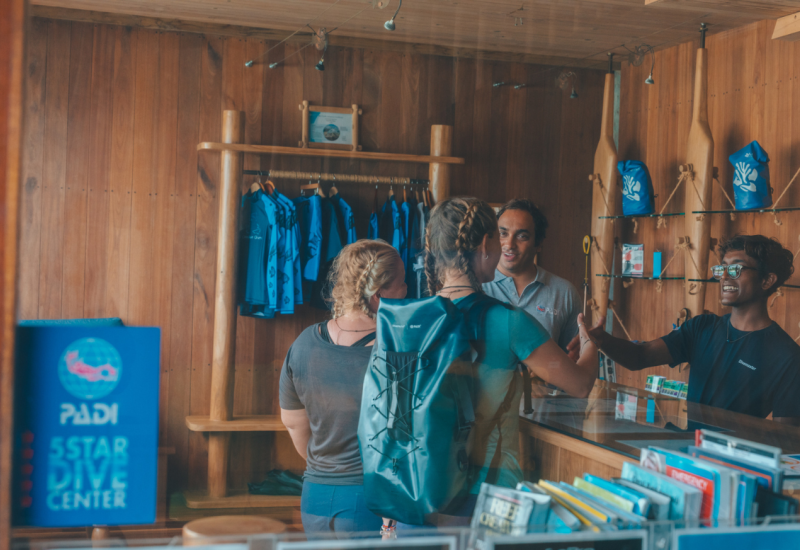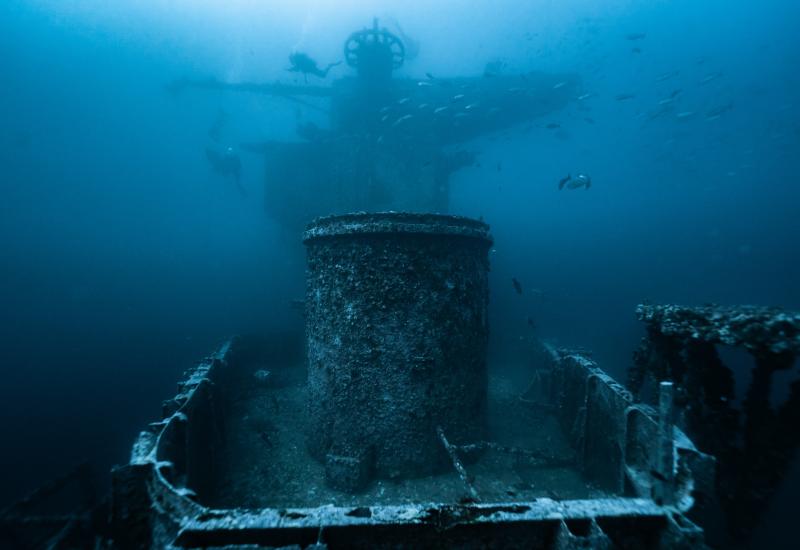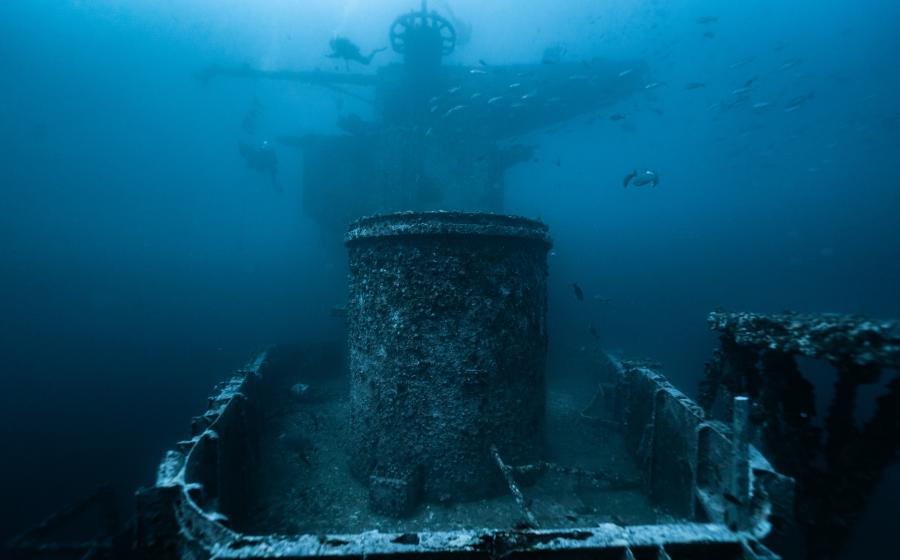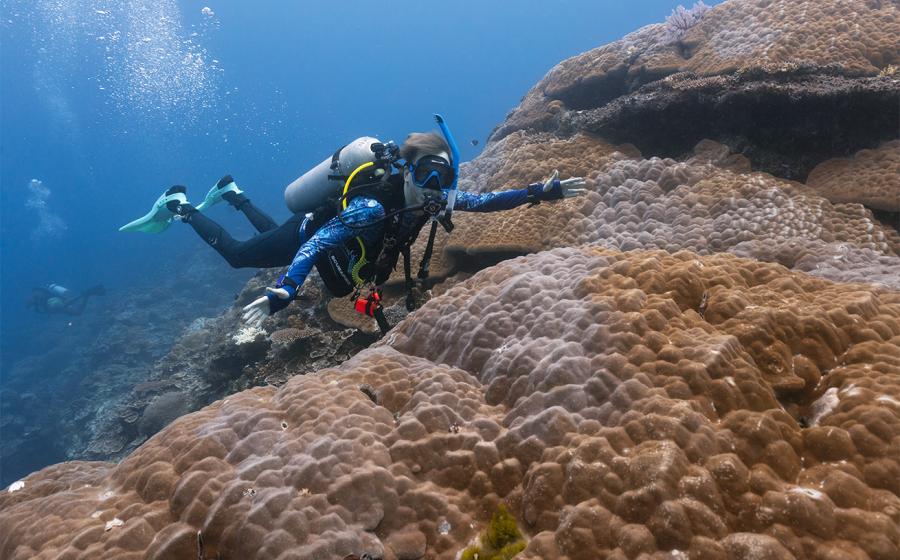Thunder Bay, Alpena, Mich.
December 2007
By Erica Blake
I had seen them before, usually on film--the small, white funnels of exhaust pipes mushrooming from the decks of freighters as they sailed the open seas. And while diving the Monrovia, an immense, upright shipwreck in Lake Huron, the muted white, tuba-like structure was just one of the hundreds of sights that piqued my interest. But the pipes were more than just pieces of an old ship. They were an exhilarating reminder of where I was--hovering in the icy waters above a deck where nearly 50 years ago, working men toiled with absolutely no clue that the ship they called home would soon plunge 150 feet to the lake bottom.
That's the story of the Great Lakes.
Partly because of a lack of radar technology, dozens of ships in the late 19th and early 20th centuries met their demise in northwest Lake Huron's Thunder Bay--not to be confused with the Ontario city of the same name. Today, 14 sunken vessels are entombed in an underwater graveyard at Thunder Bay National Marine Sanctuary and Underwater Preserve, which covers some 448 square nautical miles (the Monrovia lies just outside the sanctuary's boundaries). The area--including the following four amazing wrecks--attracts researchers and scuba divers eager to discover the region's rich maritime history.
William Peter Thew
A 132-foot wooden lumber steamer, the William Peter _Thew__ sank in a foggy 1909 collision with the larger steel steamer _William Livingston. Another steamer--the Mary C. Elphicke_--emerged from the fog to save the crew of 12, but the _Thew, on a return voyage without cargo, plunged quickly to the floor 80 feet below.
Today, the Thew is known for its immense rusty windlass covered in growth that dominates the ship's otherwise broken up bow. And there is plenty more to explore, including the ship's four-bladed propeller and a marine firebox boiler connected to the engine by a steam pipe.
But it is what lies just off the wreck, pointing north-northwest, that stands as the ship's most unique characteristic. There, lying in the sand, is the sheared off top part of the deck from the bow, almost as if a second wreck is located nearby.
The Nordmeer
The top deck of this mostly submerged 470-foot steel freighter protrudes from the water like a small island, beckoning the gulls and double-crested cormorants that usually can be found resting on its railings. This oceangoing vessel, whose name is German for "North Sea," was grounded on the shallow shoals of Lake Huron in 1966, in November--a notorious month for gale storms. After the captain took a wrong turn, he and his 43-person crew found themselves firmly stuck in about 40 feet of water, with half the ship towering above the waterline. The Nordmeer_--whose maximum diving depth is 40 feet--was bound for Chicago with a cargo of 990 rolls of steel wire. Captain and crew were all eventually rescued by another ship and the wire was salvaged. But because of the _Nordmeer's precarious position and proximity to shore--just six miles from Michigan's Alpena County--souvenir hunters have plucked plenty of keepsakes from her dry upper cabins, including keys, chains, life preservers, and even medical X-rays of crew members. State law now imposes heavy fines and possible jail time on anyone caught removing items from shipwrecks without a permit, but years of salvaging means no cargo is visible on the still sinking ship. Instead, four decades of harsh winters and layers of ice have slowly crumbled the Nordmeer into a playground of mangled shapes covered in a carpet of plant growth. Some observers suspect her top deck will not last through this winter. Visitors to the sanctuary's Great Lakes Maritime Heritage Center can view some salvaged Nordmeer cargo.
The Grecian
This 296-foot wooden schooner sank in June 1906, after running ashore in a thick fog, significantly damaging her bottom. Her top deck is at 70 feet and the bottom is at 105 feet. The Grecian's most impressive attribute is a spectacular view of her nearly intact bow that rises about 80 feet off the silty floor. A photographer and I dived the schooner with researchers from the National Oceanic and Atmospheric Administration, the agency that oversees Thunder Bay and 13 other underwater sanctuaries. As we descended on the Grecian's stern, we found three intact decks and a mussel-encrusted propeller. On the way to her bow, we slowly swam over the massive boiler and engine, where we also found pulleys, tools and a ladder.
The Montana
The Montana, a lumber steamer that sank after a fire of an unknown origin ravaged its wooden hull, lies squarely within the sanctuary's boundaries. The 236-foot-long vessel sank 75 feet to the lake bed in 1914, with no lives lost. By descending on the stern, we immediately came across the ship's large double-steeple compound engine and a firebox boiler, measuring 11 by 15 feet, where both coal and stoking tools remain in the boiler's open doors. Swimming to the rail reveals the immense, four-bladed propeller--still standing upright. Be sure to look a few more feet behind the propeller. There, lying partially covered in the silt, and easy to miss, is the ship's broken rudder.
Revelations like these make diving Thunder Bay worthwhile. After one dive on these historically significant vessels, you'll want to return.
InDepth
Getting Around: Thunder Bay National Marine Sanctuary and Underwater Preserve is a four-hour drive northeast of Detroit and is located on the western shore of Lake Huron, in Michigan's Lower Peninsula. The town of Alpena is near Interstate 75 and can be accessed by state roads, or U.S. 23, which runs along Lake Huron.
Dive Conditions: Water temps in Thunder Bay vary, but usually hover in the 40s or 50s, so most divers wear a dry suit. Visibility varies, but is often between 40 and 50 feet.
Dive Outfitters, Charters and Education Centers: Great Lakes Divers, LLC, Rogers City, Mich. (989-734-7590, www.greatlakesdivers.com) • Great Lakes Dive Charters, Paw Paw, Mich. (269-657-6423 in winter; 269-370-3974 in summer, www.greatlakesdivecharters.com) • Great Lakes Maritime Heritage Center, Alpena, Mich. (989-356-8805, www.thunderbay.noaa.gov)
December 2007
By Erica Blake
I had seen them before, usually on film--the small, white funnels of exhaust pipes mushrooming from the decks of freighters as they sailed the open seas. And while diving the Monrovia, an immense, upright shipwreck in Lake Huron, the muted white, tuba-like structure was just one of the hundreds of sights that piqued my interest. But the pipes were more than just pieces of an old ship. They were an exhilarating reminder of where I was--hovering in the icy waters above a deck where nearly 50 years ago, working men toiled with absolutely no clue that the ship they called home would soon plunge 150 feet to the lake bottom.
That's the story of the Great Lakes.
Partly because of a lack of radar technology, dozens of ships in the late 19th and early 20th centuries met their demise in northwest Lake Huron's Thunder Bay--not to be confused with the Ontario city of the same name. Today, 14 sunken vessels are entombed in an underwater graveyard at Thunder Bay National Marine Sanctuary and Underwater Preserve, which covers some 448 square nautical miles (the Monrovia lies just outside the sanctuary's boundaries). The area--including the following four amazing wrecks--attracts researchers and scuba divers eager to discover the region's rich maritime history.
William Peter Thew
A 132-foot wooden lumber steamer, the William Peter _Thew__ sank in a foggy 1909 collision with the larger steel steamer _William Livingston. Another steamer--the Mary C. Elphicke_--emerged from the fog to save the crew of 12, but the _Thew, on a return voyage without cargo, plunged quickly to the floor 80 feet below.
Today, the Thew is known for its immense rusty windlass covered in growth that dominates the ship's otherwise broken up bow. And there is plenty more to explore, including the ship's four-bladed propeller and a marine firebox boiler connected to the engine by a steam pipe.
But it is what lies just off the wreck, pointing north-northwest, that stands as the ship's most unique characteristic. There, lying in the sand, is the sheared off top part of the deck from the bow, almost as if a second wreck is located nearby.
The Nordmeer
The top deck of this mostly submerged 470-foot steel freighter protrudes from the water like a small island, beckoning the gulls and double-crested cormorants that usually can be found resting on its railings. This oceangoing vessel, whose name is German for "North Sea," was grounded on the shallow shoals of Lake Huron in 1966, in November--a notorious month for gale storms. After the captain took a wrong turn, he and his 43-person crew found themselves firmly stuck in about 40 feet of water, with half the ship towering above the waterline. The Nordmeer_--whose maximum diving depth is 40 feet--was bound for Chicago with a cargo of 990 rolls of steel wire. Captain and crew were all eventually rescued by another ship and the wire was salvaged. But because of the _Nordmeer's precarious position and proximity to shore--just six miles from Michigan's Alpena County--souvenir hunters have plucked plenty of keepsakes from her dry upper cabins, including keys, chains, life preservers, and even medical X-rays of crew members. State law now imposes heavy fines and possible jail time on anyone caught removing items from shipwrecks without a permit, but years of salvaging means no cargo is visible on the still sinking ship. Instead, four decades of harsh winters and layers of ice have slowly crumbled the Nordmeer into a playground of mangled shapes covered in a carpet of plant growth. Some observers suspect her top deck will not last through this winter. Visitors to the sanctuary's Great Lakes Maritime Heritage Center can view some salvaged Nordmeer cargo.
The Grecian
This 296-foot wooden schooner sank in June 1906, after running ashore in a thick fog, significantly damaging her bottom. Her top deck is at 70 feet and the bottom is at 105 feet. The Grecian's most impressive attribute is a spectacular view of her nearly intact bow that rises about 80 feet off the silty floor. A photographer and I dived the schooner with researchers from the National Oceanic and Atmospheric Administration, the agency that oversees Thunder Bay and 13 other underwater sanctuaries. As we descended on the Grecian's stern, we found three intact decks and a mussel-encrusted propeller. On the way to her bow, we slowly swam over the massive boiler and engine, where we also found pulleys, tools and a ladder.
The Montana
The Montana, a lumber steamer that sank after a fire of an unknown origin ravaged its wooden hull, lies squarely within the sanctuary's boundaries. The 236-foot-long vessel sank 75 feet to the lake bed in 1914, with no lives lost. By descending on the stern, we immediately came across the ship's large double-steeple compound engine and a firebox boiler, measuring 11 by 15 feet, where both coal and stoking tools remain in the boiler's open doors. Swimming to the rail reveals the immense, four-bladed propeller--still standing upright. Be sure to look a few more feet behind the propeller. There, lying partially covered in the silt, and easy to miss, is the ship's broken rudder.
Revelations like these make diving Thunder Bay worthwhile. After one dive on these historically significant vessels, you'll want to return.
InDepth
Getting Around: Thunder Bay National Marine Sanctuary and Underwater Preserve is a four-hour drive northeast of Detroit and is located on the western shore of Lake Huron, in Michigan's Lower Peninsula. The town of Alpena is near Interstate 75 and can be accessed by state roads, or U.S. 23, which runs along Lake Huron.
Dive Conditions: Water temps in Thunder Bay vary, but usually hover in the 40s or 50s, so most divers wear a dry suit. Visibility varies, but is often between 40 and 50 feet.
Dive Outfitters, Charters and Education Centers: Great Lakes Divers, LLC, Rogers City, Mich. (989-734-7590, www.greatlakesdivers.com) • Great Lakes Dive Charters, Paw Paw, Mich. (269-657-6423 in winter; 269-370-3974 in summer, www.greatlakesdivecharters.com) • Great Lakes Maritime Heritage Center, Alpena, Mich. (989-356-8805, www.thunderbay.noaa.gov)










